
The Berlin Wall was a guarded concrete barrier that physically and ideologically divided Berlin from 1961 to 1989. Construction of the wall was commenced by the German Democratic Republic on 13 August 1961. The Wall cut off West Berlin from surrounding East Germany, including East Berlin. The barrier included guard towers placed along large concrete walls, accompanied by a wide area that contained anti-vehicle trenches, beds of nails and other defenses. The Eastern Bloc portrayed the Wall as protecting its population from fascist elements conspiring to prevent the "will of the people" from building a socialist state in East Germany.
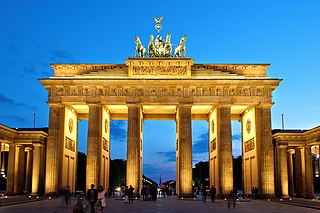
The Brandenburg Gate is an 18th-century neoclassical monument in Berlin, built on the orders of Prussian king Frederick William II after the temporary restoration of order during the Batavian Revolution. One of the best-known landmarks of Germany, it was built on the site of a former city gate that marked the start of the road from Berlin to the town of Brandenburg an der Havel, which used to be the capital of the Margraviate of Brandenburg.
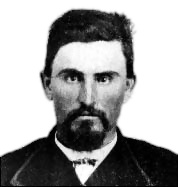
Charles Goodnight, also known as Charlie Goodnight, was an American rancher in the American West, perhaps the best known rancher in Texas. He is sometimes known as the "father of the Texas Panhandle." Essayist and historian J. Frank Dobie said that Goodnight "approached greatness more nearly than any other cowman of history." In 1955, he was inducted into the Hall of Great Westerners of the National Cowboy & Western Heritage Museum.

Charging Bull, sometimes referred to as the Bull of Wall Street or the Bowling Green Bull, is a bronze sculpture that stands on Broadway just north of Bowling Green in the Financial District of Manhattan in New York City. The 7,100-pound (3,200 kg) bronze sculpture, standing 11 feet (3.4 m) tall and measuring 16 feet (4.9 m) long, depicts a bull, the symbol of aggressive financial optimism and prosperity. Charging Bull is a popular tourist destination that draws thousands of people a day, symbolizing Wall Street and the Financial District.

Crazy Horse was a Lakota war leader of the Oglala band in the 19th century. He took up arms against the United States federal government to fight against encroachment by white American settlers on Native American territory and to preserve the traditional way of life of the Lakota people. His participation in several famous battles of the Black Hills War on the northern Great Plains, among them the Fetterman Fight in 1866, in which he acted as a decoy, and the Battle of the Little Bighorn in 1876, in which he led a war party to victory, earned him great respect from both his enemies and his own people.
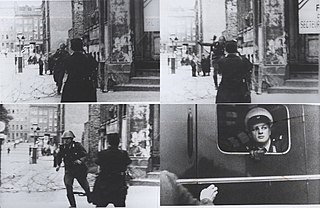
Hans Konrad Schumann was an East German border guard who escaped to West Germany during the construction of the Berlin Wall in 1961.
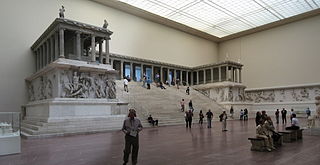
The Pergamon Altar is a monumental construction built during the reign of the Ancient Greek King Eumenes II in the first half of the 2nd century BC on one of the terraces of the acropolis of Pergamon in Asia Minor.

The Ulysses S. Grant Memorial is a presidential memorial in Washington, D.C., honoring American Civil War general and 18th United States President Ulysses S. Grant. It sits at the base of Capitol Hill, below the west front of the United States Capitol. Its central sculpture of Grant on horseback faces west, overlooking the Capitol Reflecting Pool and facing toward the Lincoln Memorial, which honors Grant's wartime president, Abraham Lincoln. Grant's statue is raised on a pedestal decorated with bronze reliefs of the infantry; flanking pedestals hold statues of protective lions and bronze representations of the Union cavalry and artillery. The whole is connected with marble covered platforms, balustrades, and stairs. The Grant and Lincoln memorials define the eastern and western ends, respectively, of the National Mall.

Ellsworth Kelly was an American painter, sculptor, and printmaker associated with hard-edge painting, Color Field painting and minimalism. His works demonstrate unassuming techniques emphasizing line, color and form, similar to the work of John McLaughlin and Kenneth Noland. Kelly often employed bright colors. He lived and worked in Spencertown, New York.

The St. Paul Building was a skyscraper in the Financial District of lower Manhattan in New York City at 220 Broadway, at the southeast corner of Broadway's intersection with Ann Street. Designed by George B. Post and completed in 1898, it was one of the tallest skyscrapers in New York City upon its completion, at 26 stories and 315 feet (96 m).

Mihintale is a mountain peak near Anuradhapura in Sri Lanka. It is believed by Sri Lankans to be the site of a meeting between the Buddhist monk Mahinda and King Devanampiyatissa which inaugurated the presence of Buddhism in Sri Lanka. It is now a pilgrimage site, and the site of several religious monuments and abandoned structures.

Veryl Goodnight is a sculptor and since 2006 has been living in Mancos, Colorado. She is known for her equine sculpture - in particular a realistic depiction of horses, often in an American West context. She was inducted into the National Cowgirl Museum and Hall of Fame in Fort Worth, Texas, in 2016.

The Wellington Monument is a statue representing Achilles erected as a memorial to Arthur Wellesley, the first duke of Wellington, and his victories in the Peninsular War and the latter stages of the Napoleonic Wars. It is sited at the south-western end of Park Lane in London, and was inaugurated on 18 June 1822. Its total height, including the sculpture, base and the mound on which it stands, is 36 ft.

The Allied Museum is a museum in Berlin. It documents the political history and the military commitments and roles of the Western Allies in Germany – particularly Berlin – between 1945 and 1994 and their contribution to liberty in Berlin during the Cold War era.

America's Response Monument, subtitled De Oppresso Liber, is a life-and-a-half scale bronze statue in Liberty Park overlooking the National September 11 Memorial & Museum in New York City. Unofficially known as the Horse Soldier Statue, it is the first publicly accessible monument dedicated to the United States Special Forces. It was also the first monument near Ground Zero to recognize heroes of the September 11 terrorist attacks.

Theodore Roosevelt, Rough Rider is a bronze sculpture by American artist Alexander Phimister Proctor, located in the South Park Blocks of Portland, Oregon in the United States. The equestrian statue was completed in 1922 and depicts Theodore Roosevelt as the leader of the cavalry regiment that fought during the Spanish–American War called the Rough Riders.
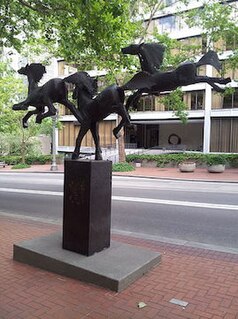
Running Horses is an outdoor 1986 bronze sculpture by Tom Hardy, located on the Transit Mall in downtown Portland, Oregon. It is part of the City of Portland and Multnomah County Public Art Collection courtesy of the Regional Arts & Culture Council.

The fall of the Berlin Wall on 9 November 1989 was a pivotal event in world history which marked the falling of the Iron Curtain and the start of the fall of communism in Eastern and Central Europe. The fall of the inner German border took place shortly afterwards. An end to the Cold War was declared at the Malta Summit three weeks later and the German reunification took place in October the following year.

The New York Stock Exchange Building is a structure in the Financial District of Manhattan in New York City, serving as the headquarters of the New York Stock Exchange. It is composed of two connected structures occupying two-thirds of the city block bounded by Wall Street, Broad Street, New Street, and Exchange Place. The central third of the block contains the original structure at 18 Broad Street, designed in the neoclassical style by George B. Post. The northern third contains a 23-story office annex at 11 Wall Street, designed by Trowbridge & Livingston in a similar style.





















